|

“Twin towers represent the split in the psyche”
On a clear board, the Rook commands 14 cells.
The Rook has the same capturing power as the Queen,
forward, backward and laterally (sideways), but cannot
take any major or minor pieces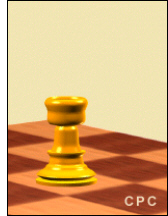 diagonally.
Both Rooks seldom have much scope for action in the early part of the game. When the board is thinned out, no time should be lost in bringing them into the fight. Endeavour to double your Rooks by placing them on the same file. In this position they sustain each other and their power will be equal to a Queen. If you can place a Rook on your opponents 7th rank this
major piece can attack the Pawns that are unmoved (in the
initial starting position) quite easily and compel your adversary to lose time defending them. The main reason for moving
both Knights and Bishops and the Queen from the back rank is that they retard
the Rooks. At the beginning of the game these major
pieces are inactive (activate them!). Many games are lost before
the Rooks are brought into play. Rooks are best on open files and ranks. At the beginning of a game, move them to the center where you will have created open files with minor piece moves.
The Rooks on the same file are known as doubled-Rooks and strong, as they support one another. They are very strong on open
columns and files where they
are not blocked by minor pieces. They have extra
strength on the seventh rank where they can trap the
opposing King on the back rank in the
pursuit and checkmate of the enemy King. diagonally.
Both Rooks seldom have much scope for action in the early part of the game. When the board is thinned out, no time should be lost in bringing them into the fight. Endeavour to double your Rooks by placing them on the same file. In this position they sustain each other and their power will be equal to a Queen. If you can place a Rook on your opponents 7th rank this
major piece can attack the Pawns that are unmoved (in the
initial starting position) quite easily and compel your adversary to lose time defending them. The main reason for moving
both Knights and Bishops and the Queen from the back rank is that they retard
the Rooks. At the beginning of the game these major
pieces are inactive (activate them!). Many games are lost before
the Rooks are brought into play. Rooks are best on open files and ranks. At the beginning of a game, move them to the center where you will have created open files with minor piece moves.
The Rooks on the same file are known as doubled-Rooks and strong, as they support one another. They are very strong on open
columns and files where they
are not blocked by minor pieces. They have extra
strength on the seventh rank where they can trap the
opposing King on the back rank in the
pursuit and checkmate of the enemy King.
The ranks and files are the domain of
the Rooks, which can move as far as desired across empty cells up, down or across the board in a straight line. On an empty board
both Rooks, whatever cell they are on, thus have a choice of 14 cells to which they may move (8 x 8 board), 7 on the vertical line of cells through their own cell and 7 on the horizontal line.
Beginners often move a-Pawn or h-Pawn two cells, planning to get
their Rooks into play via Rook-a3 or Rook-h3. This is a very bad idea for two reasons. One is that your opponent need only un-block
both Bishops on whose diagonal a3 or h3 is located to make it inaccessible to
both Rooks. The other is that Rooks do not belong on the open board as long as they can be chased by the
pieces of your adversary.
Not only does repeatedly moving the Rooks lose developing tempo, but
Rooks may not find a safe place at all.
The proper way of developing the Rooks is by castling in order to let them cooperate with each other. They can then be placed on rank-1 in files in which they may be able to invade the enemy's territory or in which they may be useful in supporting an advanced
major or minor piece.
So, when protecting each other on rank-1, they are in a position to contest the control of an open file which your opponent prepares to seize with a Rook. When the Queens are exchanged early in a game, it is better to move the King
forward if possible, and bring the Rooks into play, instead of castling, because there is less danger to your King who may
now become a valuable auxiliary piece during the remainder of the game. It is not prudent to advance your Pawns on the side that the King has castled.
The Rook is known by different names in differing countries:
Chess piece names in
other languages
|
Language |
Piece name |
Game
name |
|
English |
Rook |
Chess |
|
French |
Tour |
Les echecs |
|
German |
Turm |
Schachspiel |
|
Italian |
Torre |
Gli scacchi |
|
Spanish |
Torre |
Ajedrez |
|
Portuguese |
Torre |
Xadrez |
|
Russian |
Lad'ya |
Shahmati |
|
Arabic |
Rukhkh |
Ash-shatranj |
|
Latin |
Turris |
Scaci |
Advice on Developing your Rooks
Rooks should be left on the back rank, at the end of effective files.
01 The most effective files are open files (files free of minor
pieces).
02 Next come openable files (files that can at any time be cleared of
minor pieces by an exchange).
03 Then come semi-open files (files that are clear of
minor pieces at least half-way along or can be so cleared).
If there are two effective files, place a Rook on each as soon as possible. If there is only one, place at least one Rook on it (if the file is open, you should if possible double
your Rooks on it, one behind the other). If there are no effective files then defer the development of
the Rooks until an effective file is made. Seize any open file with a Rook as soon as possible.
Note that a Rook commands a file just as well from the first cell in the file as from any other cell. Therefore, as a rule, keep your Rook there as long as the board remains crowded. If moved out, your Rook is exposed to attack. Rooks are stronger
major pieces than Knights or Bishops. Either Rook is usually worth roughly the same as a Bishop and two Pawns, or a Knight and two Pawns.
The Rook can move in a straight line along a rank or file, but in one direction only each go.
Rooks are not allowed to jump over an occupied cell except in the special case of castling.
Checkmate with Rook and
minor pieces
The commonest type of ending and the one that is the most often mishandled is the Rook and minor
piece finale. To play the endgame well it is essential to have a thorough grasp of the basic principles of this ending, and it is significant that the greatest mature players of endgame play have been those that excelled in this particular type of ending.
The set winning position is known as the Lucena position after a Spanish Chess writer of the 15th century. The conditions normally necessary for a win with a Rook and Pawn against Rook are as follows:
1. Opponent's King must be cut off from the promoting cell (rank-8).
2. The King must be able to reach the promotion cell or,
at the very least, be in contact with the Pawn.
It should be noted that much also depends on the file on which the
Pawn is placed. The most difficult is that on file-H (8
x 8 board) and frequently only a draw is possible in
which the previous procedure will not work as the King cannot get away from the corner cell. Having an aggressive Rook position is considered an advantage in the endgame and to force your opponent into having passive Rooks. A Rook proper position is behind
your own or an enemy Pawn.
Movement and capture
The Rook moves an arbitrary number of cells in horizontal or vertical direction, but may not jump over occupied cells. Rooks
take in the same way as they move without taking. It
moves forwards, backwards and sideways as many squares
as it likes. Up and down, left and right. A Rook can be
blocked by a friendly piece.
A Rook can capture an enemy piece by moving onto its
square. To make a capture you take the enemy piece off the board and replace your piece on that square. It's
not the same as Checkers (Draughts) - you do not capture by jumping over an enemy piece.
|
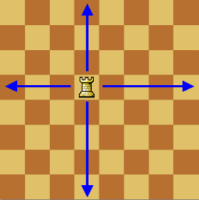
|
|
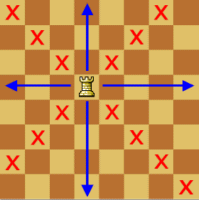
|
| |
|
|
|
The diagram shows how the Rook moves. It can move to any horizontal (right & left) or vertical (up & down) squares at a time. Players start with 2 Rooks each. |
|
|
|
Rooks are not allowed to move diagonally as shown above with red marks. Rooks and Kings are the only two pieces that make a double move in
castling. |
|
|
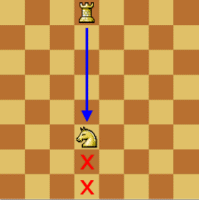 |
|
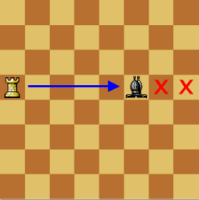 |
| |
|
|
|
Here, the Rook is blocked by a friendly piece. The Rook cannot move to the square occupied by the Knight nor the squares that lie beyond
such as d2 or d1. |
|
|
|
The Rook may capture the black Bishop by removing it from the board and placing itself on the square f5 but cannot move to squares g5 or h5 (red marks). |
|
|
Notes: for more information on the usual Chess Rook, see Chesmayne
illustrated rules of Chess or the FIDE laws of Chess.
Rook
historical notes
The Rook was a major piece that already appeared
in the first variant of Chess: Chaturanga. Its movement
nowadays is still the same as it was about one and a
half millennium ago. In Chaturanga, it was called Ratha,
a Sanskrit word meaning chariot. The Arabs still called
the piece chariot, in their language Rukh.
In medieval times, it was adapted to the Italian language using the word rocco (because the two words sound alike), which means tower.
In several languages, the Rook is called tower (e.g., Turm in German, Toren in Dutch.) Hence the representation of the
major piece as a tower or castle. Officially, the piece (in English) is called a
Rook, although it sometimes is referred to as a castle.
Rook graphics
|